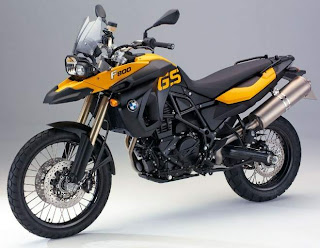 Can-Am Spyder RS Roadster
Can-Am Spyder RS Roadster Can-Am Spyder RS Roadster
Can-Am Spyder RS Roadster
 Can-Am Spyder RS Roadster
Can-Am Spyder RS Roadster
The all-new Can-Am Spyder RT is powered by a 998cc Rotax v-twin and features Bosch-engineered bits like a vehicle stability system, ABS, traction control and stability control. An optional trailer, which provides 622 litres of storage space, is also available and is compatible with the vehicle’s stability system.
Features and SpecificationsRotax 990 V-Twin Engine
3-spoke aluminum wheels
Multi-Function gauge display
Storage
Mechanical reverse
44-Liter Front Storage - Lockable front storage with 44 liters of space. Can fit two helmets.
3-Spoke Aluminum Wheels - A unique, die-cast aluminum design that echoes the RS roadster's distinctive footprint.
Vehicle Stability System (VSS) - The Y-architecture enables the Spyder to host an innovative and unique stability system. Developed in conjunction with Bosch, the Vehicle Stability System (VSS) reduces the risk of losing control, integrated into Vehicle Stability System (VSS) and Stability Control system (SCS), Traction Control System (TCS) and Anti-lock Braking System (ABS) functions.
TRANSMISSION OPTIONS
Manual 5-speed gearbox, true mechanical reverse (SM5).
Semi-automatic finger-trigger shifting (SE5).
2010 Can-Am Spyder RS Roadster - North American Specifications North America MSRP: starting at $16,499 USDEngine
ROTAX Engine
Manufacturer BRP-Rotax
Type 990 V-Twin
Displacement 998cc (60.90 cu. in.)
Bore 97 mm (3.82 in.)
Stroke 68 mm (2.68 in.)
Cylinder 2
Valves per cylinder DOHC 4
Max output 106 hp @ 8500 RPM (79 kW @ 8500 RPM)
Max torque 77 lb.-ft. @ 6250 RPM (104.3 Nm @ 6250 RPM)
Compression ratio 10.8:1
Ignition type Electronic ignition with dual output coil
Lubrication 5W40 semi-synthetic oil
Exhaust system 2-into-1 with catalytic converter
Cooling Liquid-cooled
Injection Multi-point EFI with 57 mm-diameter throttle bodies
Drive TrainGear box 5-Speed manual (SM5) with transmission-based reverse
Optional gear box 5-Speed semi-automatic (SE5) with transmission-based reverse
Final drive 28/79 ratio final drive with
Kevlar-reinforced drive belt
Clutch Wet, multi-plate, manual operation through a hydraulic piston
Electric Equipment
Magneto 500 Watts
Starter Electric
Battery Sealed maintenance-free, 12V, 21 Amp
GeometryFront suspension Double A-Arm with anti-roll bar
Front suspension travel 5.67 in. (145 mm) shocks
Rear suspension Swing-arm with monoshock
Rear suspension travel 5.67 in. (145 mm) with adjustable cam
Chassis type SST Spyder (Surrounding Spar Technology)
Steering DPS (Dynamic Power Steering)
Tires & WheelsFront tire KR21 165/65R14
Front nominal pressure 13-17 psi (90-117 kPa)
Rear tire KR21 225/50R15
Rear nominal pressure 26-30 psi (179-207 kPa)
Wheel size, front Aluminum 14x5 (355x127)
Wheel size, rear Aluminum 15x7 (381x178)
BrakesType Foot-actuated, fully integrated hydraulic 3-wheel braking system
Front braking system 4 piston calipers with 10.2 in. x 0.25 in. (260 mm x 6 mm) discs
Rear braking system Single-piston caliper with 10.2 in. x 0.25 in. (260 mm x 6 mm) disc
EBD Electronic Brake Distribution
ABS Anti-lock Braking System
Parking brake Mechanical, foot actuated to the rear caliper
Safety & SecurityVSS Vehicle Stability System
ABS Anti-lock Braking System
TCS Traction Control System
SCS Stability Control System with roll-over mitigation
DPS Dynamic Power Steering
DESS Digitally Encoded Security System
Vehicle Dimensions & Weights
Dry vehicle weight 699 lb. (317 kg)
Front storage capacity 11.62 US gal. (44 l)
Front max load capacity 30 lb. (15.9 kg)
Total vehicle load allowed 440 lb. (200 kg)
Fuel capacity 7.13 US gal. (25 l)
Oil capacity 1.19 US gal. (4.5 l)
Coolant capacity 0.85 US gal. (3.2 l)
GVWR 1,188 lb. (540 kg)
Ground clearance 4.5 in. (115 mm)
Vehicle overall height 45.1 in. (1,145 mm)
Vehicle overall length 105 in. (2,667 mm)
Vehicle overall width 59.3 in. (1,506 mm)
Seat (top) height 29 in. (737 mm)
Wheel base 68 in. (1,727 mm)
Wheel track, front 51.5 in. (1,308 mm)
Type of gas Unleaded, 87 octane minimum
 The car combines the high-tech racing features with electric-mobility to offer a fascinating range of qualities. The new car promises to deliver a fuel consumption of just 3 (three) liters/100 kilometers (equal to approximately 78 mpg U.S.), outstanding for a sports car and will deliver just 70 grams of CO2 per kilometer. Don’t think the cars hasn’t good performances, because the 918 Spyder Concept will sprint from 0 to 100 km/h in just 3.2 seconds, while the top speed is limited electronically to 320 km/h (198 mph).
The car combines the high-tech racing features with electric-mobility to offer a fascinating range of qualities. The new car promises to deliver a fuel consumption of just 3 (three) liters/100 kilometers (equal to approximately 78 mpg U.S.), outstanding for a sports car and will deliver just 70 grams of CO2 per kilometer. Don’t think the cars hasn’t good performances, because the 918 Spyder Concept will sprint from 0 to 100 km/h in just 3.2 seconds, while the top speed is limited electronically to 320 km/h (198 mph).




















